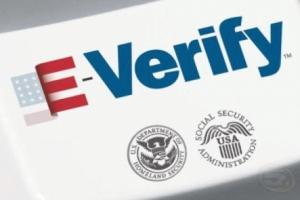ImmigrationCalifornia leads nation in E-Verify adoption despite concerns
In the past year California saw a 37 percent surge in E-Verify enrollment by businesses, making it the largest adopter of the system in the United States; unlike other states that have made E-Verify mandatory for public and private employers, California legislators recently passed a law that bans local governments from forcing businesses to sign on to the program

California leads all states in number of E-Verify participants // Source: brilyuhnt.com
In the past year California saw a 37 percent surge in E-Verify enrollment by businesses, making it the largest adopter of the system in the United States.
So far more than 90,000 businesses in the state have signed on to the free federal program which allows employers to check the immigration status of prospective employees by running their information against DHS and Social Security databases.
Unlike other states that have made E-Verify mandatory for public and private employers, California legislators recently passed a law that bans local governments from forcing businesses to sign on to the program.
The voluntary option appears to be an effective strategy as California has more job sites using E-Verify than any other state.
According to Ann Cun, the counsel on best practices at INSZoom, a workplace consulting firm, California retailers have been particularly interested in joining the program in recent months.
Cun explained that the recent series of Immigration and Customs Enforcement (ICE) audits on major companies that resulted in large firings and fines have made retailers worried.
She pointed to an incident in 2009, right before Christmas, where a Target store in Walnut Creek, California was audited by ICE investigators and forced to fire forty immigrant workers on an overnight shift.
“Employers have been finding out about the E-Verify program mainly after reading about these raids,” Cun said. “That’s usually what triggers companies to evaluate whether they want to enroll.”
As California businesses have rushed to join E-Verify, the agricultural sector has been conspicuously missing and is among the least represented industries in the E-Verify program.
“There is one industry that I believe has historically shown it relies on foreign labor, and that’s agriculture,” said Representative Dan Lungren (R –California).
Lungren believes that forcing E-Verify on all California employers would devastate the state’s agricultural sector.
“You’re going to destroy agriculture in a very real sense,” he said. “I don’t think I’m being an alarmist about that.”
Critics of the program also point to Alabama, where farmers have struggled with labor shortages after state lawmakers passed a tough new immigration law.
“Those who are proponents of restrictive ordinances would say, ‘That’s exactly what we’re trying to do.’ But we’re not looking just at the effect on immigrants,” said Jason Marczak, the policy director for the Americas Society/Council of the Americas. “We’re looking at the overall effect on the number of jobs, the number of employees and the city as a whole.”
“Restrictive ordinances are bad for business, and nonrestrictive ordinances are comparatively better for the business environment,” Marczak said.
E-Verify’s opponents also say the system is inaccurate and has resulted in thousands of legal immigrants losing their jobs because of erroneous results.
In 2009 the Migration Policy Institute found that E-Verify’s 1 percent error rate would result in the incorrect rejection of roughly 600,000 legal immigrants and U.S. citizens each year if the system became mandatory.
Meanwhile Westat, a firm contracted by U.S. Citizenship and Immigration Services, found that E-Verify failed to catch 54 percent of illegal workers run through the system because it cannot detect identity fraud.
If a worker is flagged as illegal, they have the right to challenge the results and DHS will manually check their records. In 2010, of the employees who challenged their E-Verify results, 18 percent, or 47,000 employees, were determined to be legal workers.
Despite these concerns, many companies have gone ahead and signed up for the program for fear of being targeted and fined by ICE auditors.
For instance the meatpacking and processing industry were some of the earliest adopters of the system and even used an early version of electronic verification in the 1990s prior to the introduction of E-Verify.
“When you’re in that kind of industry, whether it’s clothing-making or animal-processing, you get a lot of illegal immigrants trying to get those jobs,” said Jeremy Russell, a spokesman for the National Meat Association. “It’s easier for ICE to target us for raids. You have a big factory.”
Russell noted that E-Verify can provide a false sense of security. As an illustrative example, Russell pointed to Swift & Co., an early adopter of E-Verify that had been raided in six states in 2006 partially because E-Verify had failed to identify illegal workers who had used stolen Social Security numbers.
“That raid really put it on the map for everybody. You can’t just turn on E-Verify and say everything’s fine,” Russell said.
Lungren acknowledged the shortfalls of the system, but still believes it is an important and useful system to use.
“Overall, for the companies that have chosen to voluntarily participate, it’s worked very, very well,” Lungren said. “It’s not a fail-safe system, but it’s miles ahead of everything else.”
